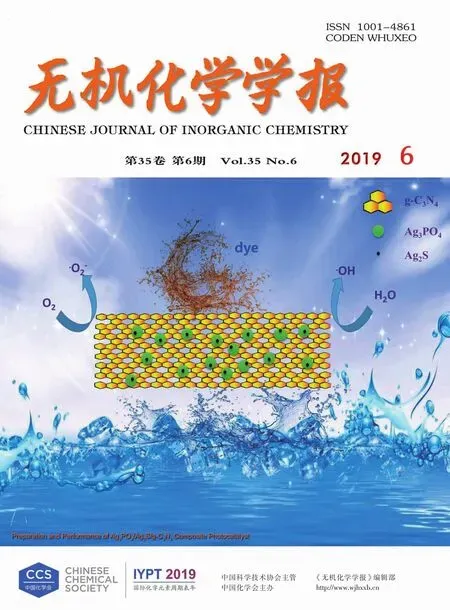Salamo型三核镍ギ配合物的合成、晶体结构与Hirshfeld表面分析
于 盟 穆浩冉 刘玲芝 李 娜 白 杨 董秀延
(兰州交通大学化学与生物工程学院,兰州 730070)
0 Introduction
As we known,Salen and its derivatives[1-4]are extremely important N2O2chelating ligands in organometallic and coordination chemistry.Not only their transition metal complexes[5-9]are widely studied in the biological fields[10-17],but also there are certain advantages in luminescent[18-25]and magnetic[26-31]materials,electrochemical fields[32-33],supramolecular constructions[34-38],and so on.
As derivatives of Salen,in recent years,our research mostly concentrated on the syntheses of Salamo-type ligands[39-46].These compounds have been investigated in forming metal complexes with interesting properties[47-48],and some works have been devoted to synthesize and characterize mono-[49],diand multi-nuclear metalギcomplexes bearing Salamo ligand and its derivatives[50-51].Herein,as part of our ongoing interest in Salamo-type complexes,we have described the syntheses,crystal structures,and Hirshfeld surfaces analyses of two trinuclear Niギcomplexes,which were constructed from Salamo-type bisoxime ligands 5-methoxy-2,2′-(ethylenedioxybis(azomethine))diphenol(H2L1)and 4,4′-dinitro-2,2′-(ethylenediyldioxybis(nitrilomethylidyne))diphenol(H2L2).
1 Experimental
1.1 Materials and methods
All chemical reagents are analytical pure reagents,which have not been purified before used.C,H and N analyses were obtained using a GmbH Vario EL V3.00 automatic elemental analyzer.Elemental analysis for Niギ was conducted using an IRIS ER/S·WP-1 ICP atomic emission spectrometer.1H NMR spectra were recorded using a Bruker AVANCE DRX-400 spectrometer.The melting points were determined by microscopic melting point instrument made in Beijing Tektronix Instruments Limited Company.IR spectra were recorded on a VERTEX70 FT-IR spectrophotometer,with samples prepared as KBr(500~4 000 cm-1)and CsI(100~500 cm-1)pellets.UVVis absorption spectra were recorded on a Shimadzu UV-2550 spectrometer.
1.2 Synthesis of H 2L 1
The asymmetric Salamo-type ligand H2L1was synthesized by a modified method reported in the earlier literature(Scheme 1)[24].
To an ethanol solution (30 mL)of 4-methoxy-2-hydroxybenzaldehyde (316.62 mg,2.08 mmol)was added an ethanol solution(20 mL)of 1,2-bis(aminooxy)ethane (289.32 mg,3.14 mmol).The mixture solution was heated at 50~55 ℃ for 5 h.The solution was concentrated in reduced pressure to obtain 210.37 mg of yellow solid,2-(O-(1-ethyloxyamide))oxime-5-methophenol.Yield:44.68%,m.p.96~98 ℃.Anal.Calcd.for C10H14N2O4(%):C 53.09,H 6.24,N 12.38;Found(%):C 53.08,H 6.25,N 12.36.
A solution of above-obtained 2-(O-(1-ethyloxyamide))oxime-5-methophenol(210.37 mg,0.93 mmol)in ethanol(20 mL)was added dropwise to a solution of salicylaldehyde (107.03 mg,0.88 mmol)in ethanol(15 mL),and the mixture was heated at 50~55 ℃ for 3 h.After cooling to room temperature,the solution was concentrated in reduced pressure.The residue was purified by column chromatography(SiO2,chloroform/ethyl acetate,10∶1,V/V)to afford 139.26 mg colorless flocculent crystalline solid (H2L1).Yield:48.1%.m.p.69~71 ℃.1H NMR(400 MHz,CDCl3):δ3.81(s,3H,CH3),4.44(m,4H,CH2),6.46~6.49(m,2H,ArH),6.89~6.92(d,J=12 Hz,1H,ArH),6.97~6.99(d,J=8 Hz,1H,ArH),7.04~7.06(d,J=8 Hz,1H,ArH),7.15~7.17(d,J=8 Hz,1H,ArH),8.18(s,1H,CH=N),8.24(s,1H,CH=N),8.25(s,1H),9.75(s,1H,OH),9.92(s,1H,OH).Anal.Calcd.for C17H18N2O5(%):C 61.81,H 5.49,N 8.48;Found(%):C 61.80,H 5.50,N 8.49.

Scheme 1 Synthesis route of H2L1
1.3 Synthesis of H 2L 2
The reaction route is shown in Scheme 2.4,4′-Dinitro-2,2′-(ethylenediyldioxybis(nitrilomethylidyne))diphenol (H2L2)was synthesized according to the method reported earlier[39].Yield:80.0%,m.p.202~203℃,Anal.Calcd.for C16H14N4O8(%):C 49.24,H 3.62,N 14.35.Found(%):C 49.33,H 3.58,N 14.04.1H NMR(400 MHz,DMSO-d6):δ4.44(s,4H),7.03(d,J=9.2 Hz,2H),8.09 (dd,J=9.2,2.6 Hz,2H),8.35(d,J=2.6 Hz,2H),8.37(s,2H),10.13(s,2H,OH).

Scheme 2 Synthesis route of H2L2
1.4 Synthesis of complex 1
A n-propanol solution(3.0 mL)of nickelギacetate tetrahydrate (2.46 mg,0.01 mmol)was added to a dichloromethane solution(2.0 mL)of H2L1:5-methoxy-2,2′-(ethylenedioxybis(azomethine))diphenol(3.31 mg,0.01 mmol)at room temperature.After the mixture was stirred for 2 h,the mixture was filtered off.The resulting filtrate was left undisturbed for about one week to form block-like crystals suitable for X-ray crystallographic analysis.Yield:40.5%.Anal.Calcd.for C50H70Ni3N4O18(%):C 50.41,H 5.92,N 4.70;Ni 14.78;Found(%):C 50.60;H 5.98;N 4.52;Ni 14.62.
1.5 Synthesis of complex 2
A solution of nickelギacetate tetrahydrate(2.48 mg,0.01 mmol)in n-butanol(3 mL)was added dropwise to a solution of H2L2(3.90 mg,0.01 mmol)in acetonitrile (3 mL)at room temperature.The color of the mixing solution turned yellow immediately,and was stirring continually for 1h at room temperature.The mixture was filtered and the filtrate was allowed to stand at room temperature for about three weeks.The solvent was partially evaporated and several green prismatic single crystals suitable for X-ray crystallographic analysis were obtained.Yield:47.8%.Anal.Calcd.for C52H70Ni3N8O24(%):C 45.68,H 5.16,N 8.20,Ni12.88;Found(%):C 45.90,H 5.22,N 8.02,Ni12.63.
1.6 Crystal structure determinations of complexes 1 and 2
X-ray single crystal diffraction data of complexes 1 and 2 were recorded using a Super Nova Dual(Cu at zero)diffractometer with a monochromated Mo Kα radiation(λ=0.710 73 nm)at294.29(10)and 293.84(19)K,respectively.The Lp factor semi-empirical absorption corrections were applied using the SADABS program[52a].The structures were solved by the direct methods(SHELXS-2014[52b]).All hydrogen atoms were added theoretically and difference-Fourier map revealed the positions of the remaining atoms.All nonhydrogen atoms were refined anisotropically using a full-matrix least-squares procedure on F2with SHELXL-2014[52b].The structure contained large void,and the solvent molecules and the positive or negative ions locating in the void couldn′t be identified because they were highly disordered and had so small residual peak.Therefore,SQUEEZE in PLATON program was performed to remove the highly disordered solvent and ions.The structures were then refined again using the data generated.The crystal data and experimental parameters relevant to the structure determinations are listed in Table 1.
CCDC:1589650,1;1589813,2.

Table 1 Crystal data and structure refinement parameters for complexes 1 and 2

a R1=∑||F o|-|F c||/∑|F o||;b wR2={∑w(F o2-F c2)2/∑[w(F o2)]2}1/2.
2 Results and discussion
2.1 IR spectra
The FT-IR spectra of H2L1and H2L2with their corresponding complexes 1 and 2 exhibited various bands in the 4 000~400 cm-1region (Fig.1 and Table 2).The infrared spectra of the ligand H2L1and its complex 1 are shown in Fig.1(a).The ligand H2L1had a strong absorption peak at 3 165 cm-1,which belongs to the stretching vibration of the phenolic hydroxyl groups,while complex 1 exhibited a new vibration peak at 3 405 cm-1,indicating the presence of nbutanol molecules.This result is consistent with the previous element analysis results.It can be seen from Fig.1 and Table 2 that the stretching vibration absorption peak of theνC=Nbond in the ligand H2L2appeared at 1 632 cm-1, and that of complex 1 appeared at 1 609 cm-1.The peak-to-low wavenumber is shifted by 23 cm-1[64-65],indicating that the Niギions coordinate to the oxime nitrogen atoms,giving rise to reduction in the bond energy of the C=N bond.

Fig.1 FT-IR spectra of the ligands and their complexes 1 and 2

Table 2 Main absorption peaks in FT-IR spectra of the ligands and their complexes 1 and 2 cm-1
As shown in Fig.1(b),the stretching vibration absorption peaks of νC=Nand νAr-Oin the ligand H2L2appeared near 1 613 and 1 271 cm-1,whereas those of complex 2 appeared at 1 607 and 1 234 cm-1,respectively[66-67],and moving toward the direction of low wave number.
The far-IR spectra (550~100 cm-1)of both complexes 1 and 2 were also obtained so as to identify the bonds of Ni-O and Ni-N frequencies.The bands at 419 and 422 cm-1of complexes 1 and 2 can be attributed toνNi-O,while the bands at 590 and 552 cm-1are assigned toνNi-N,respectively[34].
2.2 UV-Vis spectra
The UV-Vis absorption spectra of the free ligands H2L1and H2L2with their corresponding complexes 1 and 2 in ethanol solutions(10 μmol·L-1)at 298 K are shown in Fig.2.
Obviously,the absorption peaks of the ligands H2L1and H2L2differ from those of complexes 1 and 2.From Fig.2(a),we can see that the ligand H2L1showed two strong absorption peaks appear near 274 and 309 nm.The former belongs to the π-π*transition of the benzene rings in the ligand molecule.The latter is assigned to the transition absorption peak of n-π*on the C=N bonds[68-69].Compared with theπ-π*transition absorption peak of the benzene rings at 274 nm of the ligand H2L1,it was red-shifted to 279.5 nm in complex 1,indicating that the Niギions have coordinated to the ligand H2L1.At the same time,the absorption peak of the ligand H2L1appearing near 309 nm disappeared in complex 1,indicating that the oxime nitrogen atoms have coordinated with the Niギions.In addition,complex 1 exhibited a new absorption peak at 349 nm.It can be seen that the Niギions chelate with two oxime nitrogen atoms and two phenol oxygen atoms to produce a charge transfer effect.
As shown in Fig.2(b),the ligand H2L2showed two absorption peaks appearing around 375 and 448 nm.The absorption peak near 375 nm is attributed to the π-π*transition of the aromatic rings in the ligand H2L2,and the absorption peak at 448 nm is attributed to the π-π*transition of the C=N bonds in H2L2.However,compared with the ligand H2L2,the positions of the absorption peaks of complex 2 were blueshifted,and the absorption peak at 448 nm was blueshifted by about 51 nm,while the absorption peak of the ligand H2L2near 375 nm disappeared.It is indicated that there are strong coordination bonds between the ligand H2L2and the Niギions in complex 2.
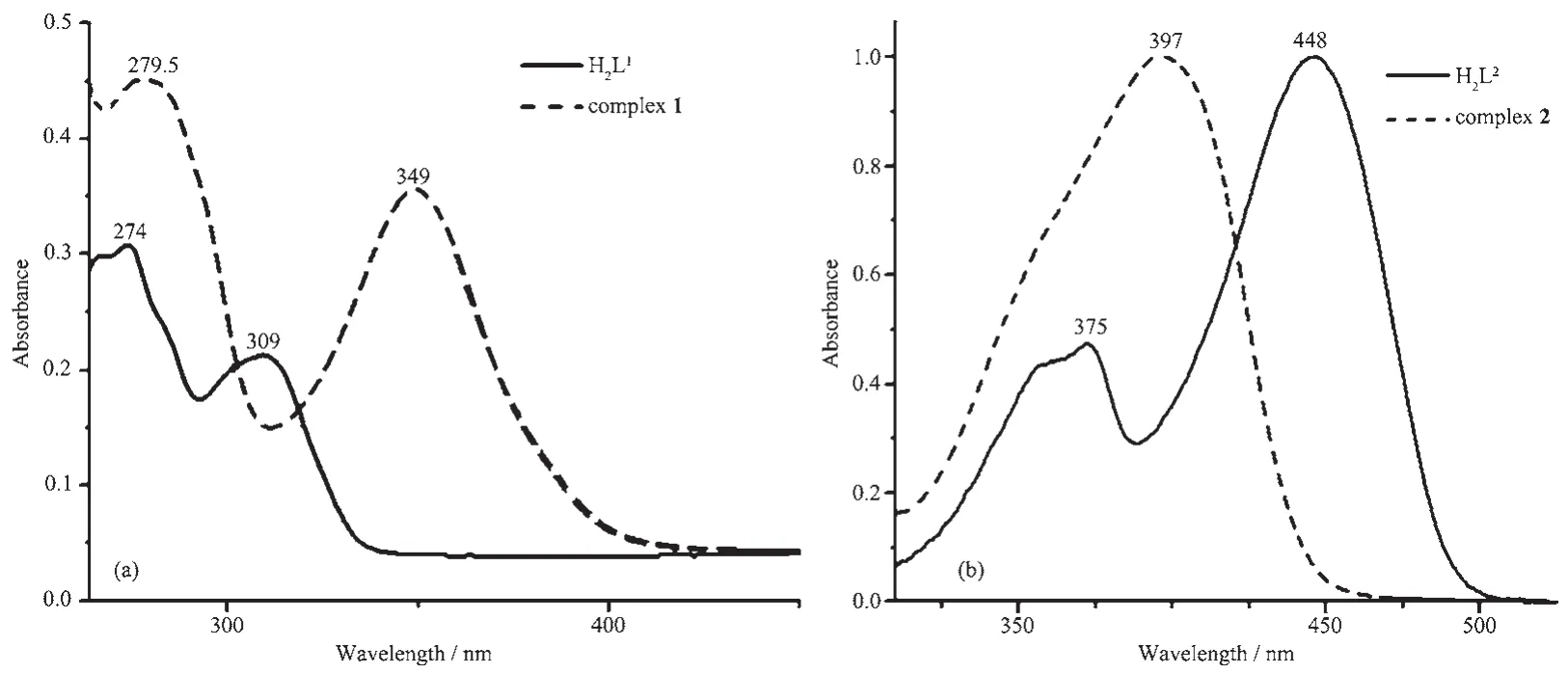
Fig.2 UV-Vis spectra of the ligands and their complexes 1 and 2
2.3 Descriptions of crystal structures
2.3.1 Crystal structure of complex 1
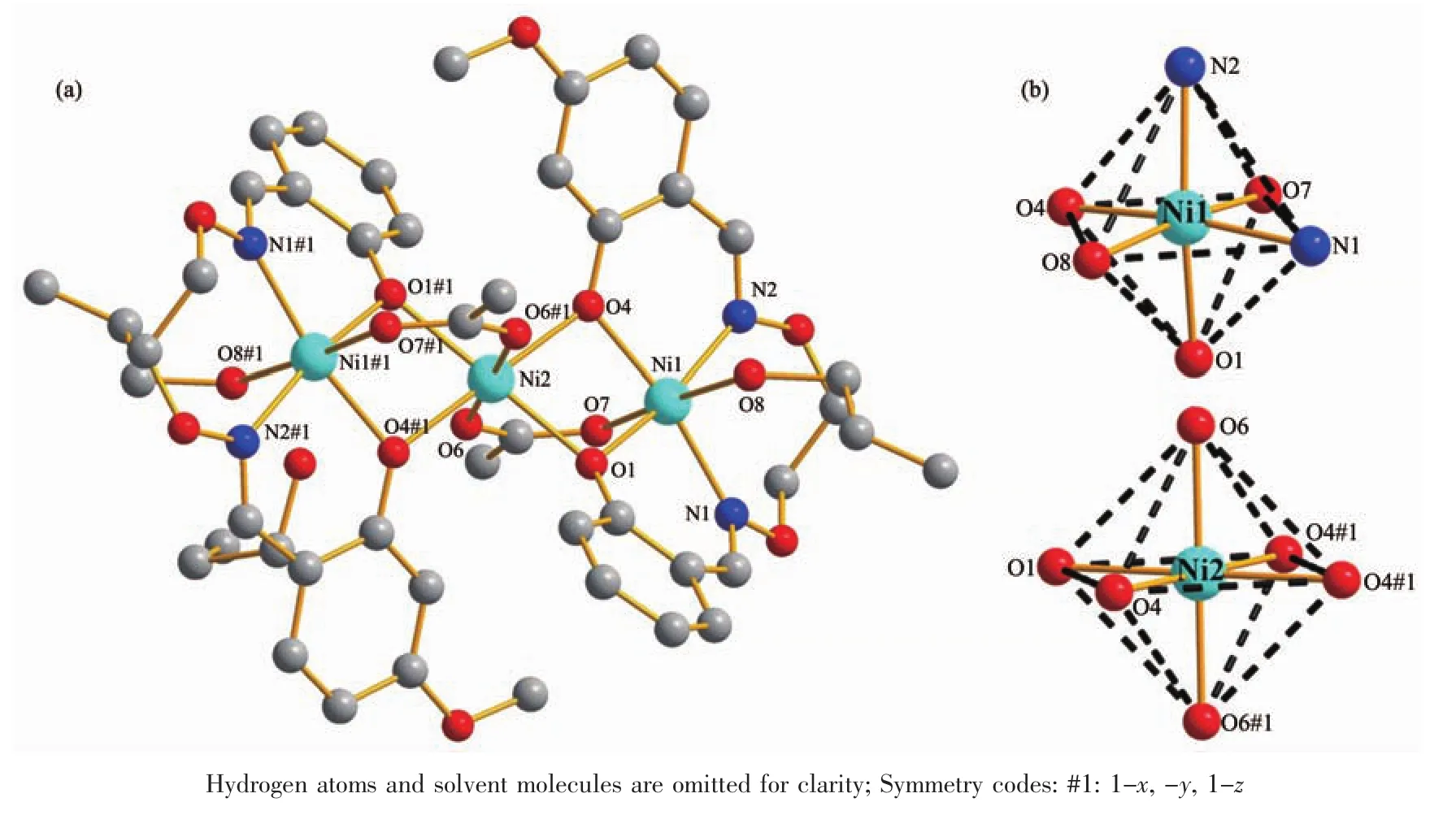
Fig.3 (a)Molecular structure and atom numberings of complex 1 with 30%probability displacement ellipsoids;(b)Coordination polyhedrons for Niギions of complex 1
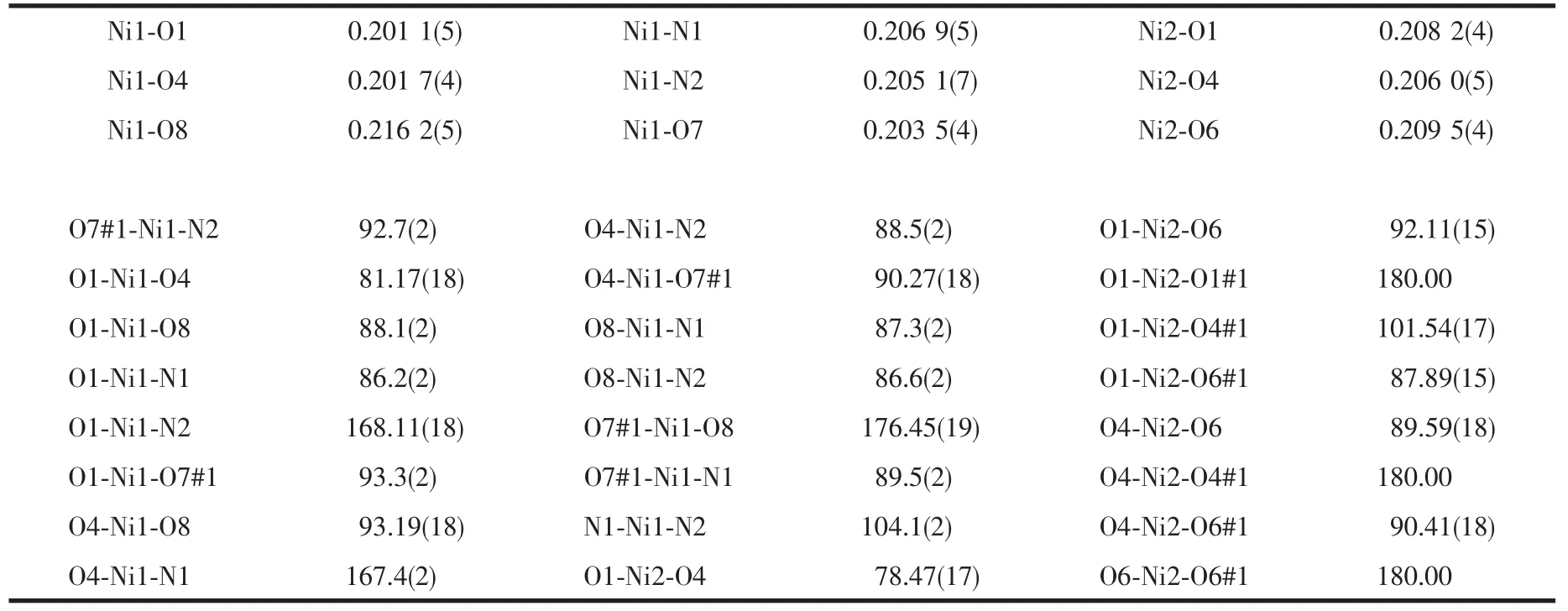
Table 3 Selected bond lengths(nm)and angles(°)for complex 1
As shown in Fig.3,in the crystal structure of complex 1,the terminal hexa-coordinated Niギion(Ni1)is located in the cis-N2O2coordination cavity(O1,O4,N1 and N2)of the completely deprotonated(L1)2-unit,and oneμ-acetate oxygen atom (O7)and one coordinated n-propanol oxygen atom (O8)occupy together the axial positions.Meanwhile,the coordination environment of the central hexa-coordinated Niギion(Ni2)is completed by quadrupleμ-phenoxo oxygen atoms from the two (L1)2-moieties and twoμ-acetate oxygen atoms (O6 and O6#1).All of the six oxygen atoms coordinate to Ni2 constituting an octahedral geometry.Theμ-acetate ligand serves as bridging group for Ni1 and Ni2 and another coordinates to Ni2 and Ni1#1,in both cases via Ni-O-C-O-Ni bridges.Then,all of the hexa-coordinated Niギions of complex 1 have slightly distorted octahedral geometries[23].
In the crystal structure of complex 1,there are two pairs of intra-molecular hydrogen bonding interactions(C8-H8B…O7#2 and C13-H13…O1#2)(Fig.4)[53-57].Table 4 summarizes the intra-molecular hydrogen bonding interactions in complex 1.As shown in Fig.5 and Table 4,the supramolecular structure of complex 1 was linked by inter-molecular hydrogen bonding interactions(O8-H8…O9,O9-H9…O6 and C8-H8A…O5#1),which performs a crucial role in constructing and stabilizing 1D supramolecular chain structure[58].

Table 4 Hydrogen bonding interactions for complex 1
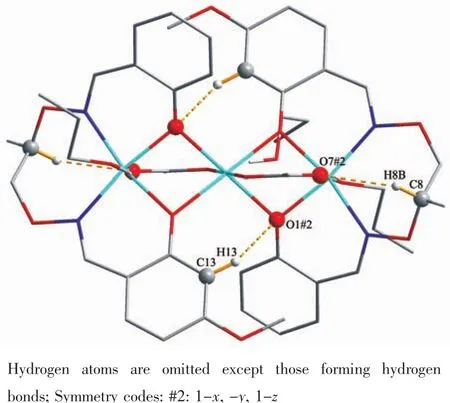
Fig.4 View of the intra-molecular hydrogen bonding interaction of complex 1
2.3.2 Crystal structure of complex 2
X-ray crystallographic analysis of complex 2 revealed symmetric trinuclear structure.It crystallizes in the triclinic system,space group P1.Three Niギions,two completely deprotonated(L2)2-units,two coordinated n-butanol molecules and twoμ-acetate result in a symmetrical trinuclear Niギcomplex.Selected bond lengths and angles are listed in Table 5.

Fig.5 View of inter-molecular hydrogen bonding interactions of complex 1
As shown in Fig.6,the hexa-coordinated terminal Niギion (Ni1 or Ni#1)lies in the N2O2coordination sphere (O1,O8,N2 and N3 or O1#1,O8#1,N2#1 and N3#1)of(L2)2-,and coordinates with oneμ-acetate oxygen atom (O9 or O9#1)and one coordinated nbutanol oxygen atom(O11 or O11#1).
As illustrated in Fig.7,in the crystal structure of complex 2,there are six pairs of intra-molecular hydrogen bonding interactions(C0AA-H0AA…O3,C2-H2…O8#1,C2-H2…O10#1,C9-H9A…O9,C13-H13…O10#1 and C19-H19A…O10#1)[59-63].As shown in Fig.8 and Table 6,complex 2 molecules are linked into an infinite 2D supramolecular structure by inter-molecular hydrogen bonding interactions (C19-H19B…O3#2,C23-H23B…O7#3).

Table 5 Selected bond lengths(nm)and angles(°)for complex 2
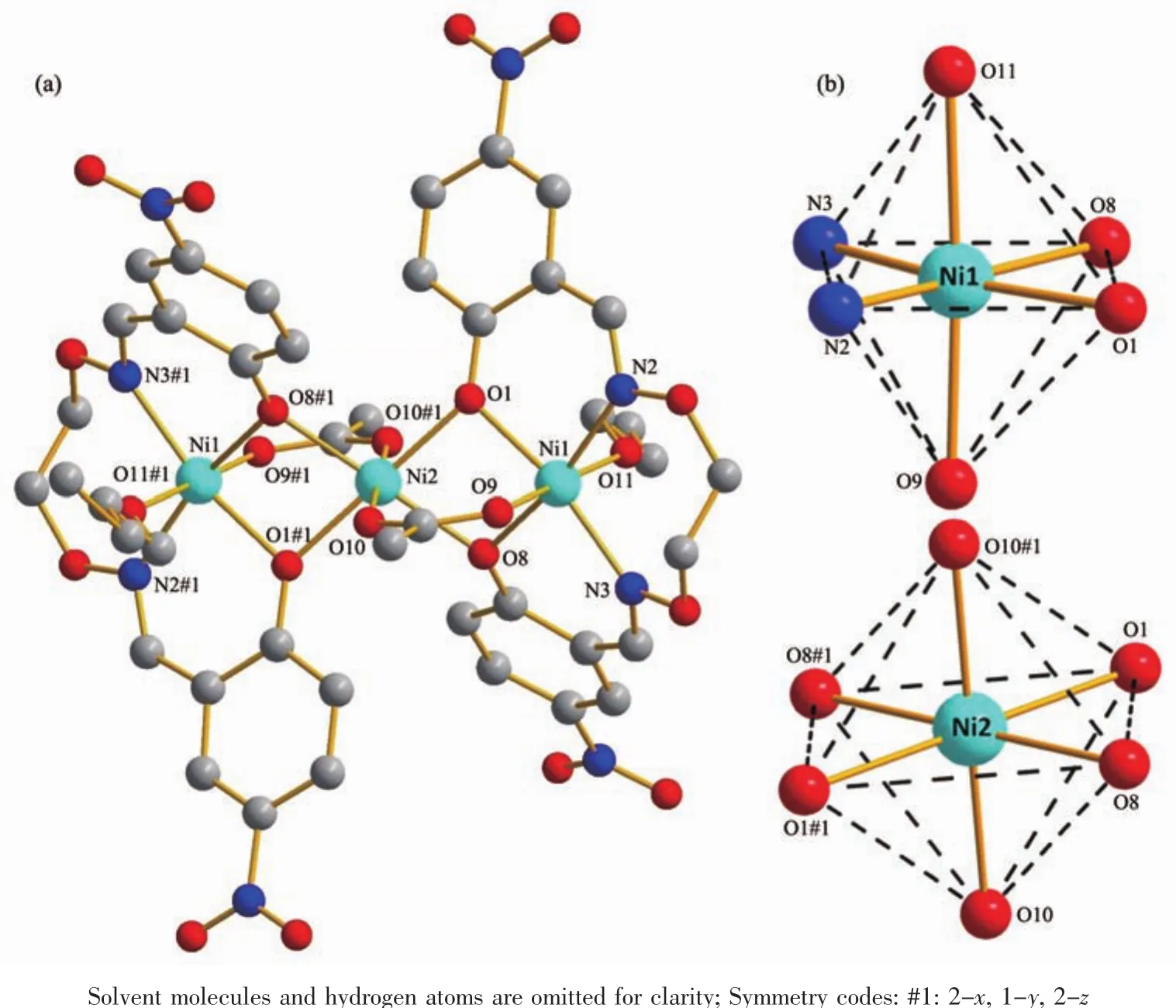
Fig.6 (a)Molecular structure and atom numberings of complex 2 with 30%probability displacement ellipsoids;(b)Coordination polyhedrons for Niギions of complex 2

Fig.7 Intra-molecular C-H…O hydrogen bonding interactions of complex 2
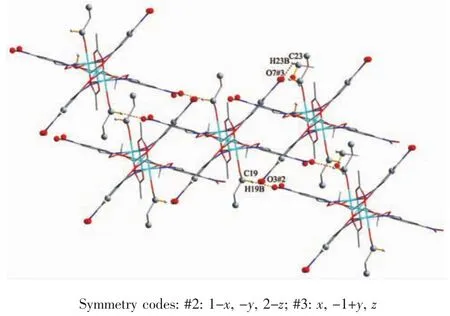
Fig.8 Two dimensional supramolecular structure formed by inter-molecular C-H…O hydrogen bonding interactions in complex 2

Table 6 Hydrogen bonding interactions for complex 2
2.4 Hirshfeld surfaces analyses
The Hirshfeld surfaces[70]of complexes 1 and 2 are illustrated in Fig.9 showing surfaces that have been mapped over dnormand the corresponding location in shape index exists the complementary region of red concave surface surrounded by receptors and the blue convex surface surrounding receptors,further proving that such hydrogen bonding exists.As for the large amount of white region in dnormsurfaces,it is suggested that there is a weaker and farther contact between molecules,rather than hydrogen bonding.
Fig.10 shows the 2D plots generated[71]from the Hirshfeld surfaces of complexes 1 and 2 corresponding to the O…H,C…H and H…H interactions.As shown in Fig.10(a),the H…H interactions appeared at(0.115 nm,0.115 nm)accounting for 66.6%of the total area of Hirshfeld surfaces for complex 1.The C…H/H…C interactions in a range of(0.160 nm,0.09 nm)appeared as a pair of symmetrical wings,accounting for 11.6%of the total area of Hirshfeld surfaces.The proportions of O…H/H…O interactions comprised 14.2%of the total Hirshfeld surfaces for each molecule of complex 1.As shown in Fig.10(b),for complex 2,the interactions of H…H appeared at(0.115 nm,0.115nm)accounting for 44.8%of the total area of Hirshfeld surfaces.The C…H/H…C interactions in a range of(0.160 nm,0.105 nm)accounted for 10.1%of the total area of Hirshfeld surfaces.The proportions of O…H/H…O interactions comprised 37%of the total Hirshfeld surfaces for each molecule of complex 2.It is because of the existence of these weaker hydrogen bonds that complexes 1 and 2 can be stable.

Fig.9 Hirshfeld surfaces analyses mapped with curvedness,d norm and shape index of complexes 1 and 2

Fig.10 Fingerprint plots of complexes 1 and 2:full and resolved into O…H,C…H and H…H contacts showing the percentages of contacts contributed to the total Hirshfeld surface area of molecule
3 Conclusions
In summary,we have reported the successful syntheses and characterizations of two newly designed trinuclear Niギ Salamo-type complexes,{[Ni(L1)(npropanol)]2(OAc)2Ni}·2(n-propanol)(1)and{[Ni(L2)(nbutanol)]2(OAc)2Ni}·2(n-butanol)(2).All of the hexacoordinated Niギions in complexes 1 and 2 are slightly distorted octahedral configurations,and complex 1 forms an infinite 1D chain-like supramolecular structure through inter-molecular hydrogen bonding interactions.The supramolecular structure of complex 2 is formed by inter-molecular hydrogen bonding interactions,resulting in a self-assembled infinite 2D supramolecular network.
Acknowledgements:This work was supported by the National Natural Science Foundation of China (Grant No.21761018)and the Program for Excellent Team of Scientific Research in Lanzhou Jiaotong University (Grant No.201706),which are gratefully acknowledged.

